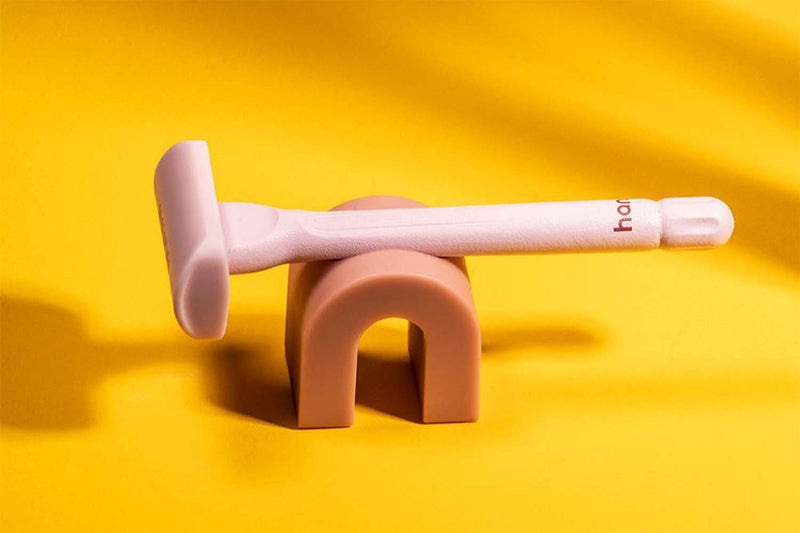Anyone who’s experienced annoying ingrown hairs knows how these red bumps, razor burns, and pimples can ruin your day. Some are quick to brush off the irritation (and even pain) of ingrown hairs, calling it “normal” or “no big deal.”
Here at Hanni, we know that ingrown hairs are totally a big deal — and we know how to stop them.
To understand how to treat and prevent ingrown hairs, we need to understand why the body develops them in the first place.
What are ingrown hairs?
Ingrown hairs are normal hairs that have started to grow back into your skin.
No matter your hair type, each hair on your body has an individual root in the top layer of your skin, aka your epidermis. dermatologists call these roots “hair bulbs.”
The hairs themselves are made of two parts: the hair follicle and the hair shaft. The follicle is the length of hair still in your epidermis, and the shaft is the length above the surface of your skin. The hair you see on your body is made of hair shafts.
Normally, your hair follicles and hair shafts grow outward, rising up from skin. However, sometimes your hair can bend between the follicle and the shaft and start curling back into the skin. This is called an ingrown hair.
Are there different types of ingrown hairs?
There are many types of ingrown hairs. While all ingrown hairs grow in the wrong direction, which direction that is can vary. Everyone has a different way to shave down there.
Sometimes, an ingrown hair will start to grow sideways, moving parallel to the skin’s surface and becoming stuck within the epidermis. Other times, a hair shaft already past the epidermis will fold in on itself and start to grow back in the direction of the skin.
In even rarer cases, a hair shaft will grow in a spiral under the skin… Ouch.
Can you get ingrown pubic hairs?
Just like the hair on the rest of your body, ingrown hairs can develop in your pubic area.
People with coarse hair are more likely to experience ingrowns because ingrown hairs are caused by a misdirection of hair growth. In fact, the majority of people who experience ingrown hairs have naturally curly hair.
Because pubic hair tends to be thicker, coarser, and curlier than a person’s other body hair, you may develop ingrown hairs in your pubic area more frequently than in your legs or armpits.
If your pubic hair is especially curly, you may find ingrown hair down there to be outright common.
What causes ingrown pubic hair?
Hair removal methods
Hair removal is the most common cause of ingrown hairs. Whether you’re plucking, tweezing, or waxing your bikini line, every hair removal option carries some risk of developing ingrown hair.
Anytime you remove a hair too close to the skin’s surface, you risk agitating your hair follicles, which can impact hair growth patterns.
For most people, hair removal means shaving. It’s true that shaving can hold an especially high risk for ingrown hairs, as a dull razor can increase the risk of hair getting stuck beneath your epidermis — but more on that later.
Even laser hair removal, which some people expect to prevent ingrown hairs, is not a foolproof solution.
Friction
Ingrown hairs can also develop from excessive amounts of friction. Remember that ingrown hairs are simply hairs growing in the wrong direction, and resistance against a hair can cause the shaft to bend.
When this resistance occurs frequently and with enough force, the hair will begin to grow in a new direction, promoting ingrown hair.
This phenomenon is especially common among women who wear certain undergarments. Your underwear is designed to protect your pubic area from the friction of your clothing (and look cute, of course).
When your favorite thong, bikini, or boyshort is too tight or doesn’t provide enough coverage, the friction of rubbing fabric can irritate the sensitive skin of your vulva.
With this irritation comes the likelihood of ingrown pubic hair.
Is ingrown hair dangerous?
In most cases, ingrown hair is not dangerous – but that doesn’t stop it from being annoying.
No matter the type of ingrown hair you have, you’ll experience at least some pain in the process. How much pain will vary depending on the type and severity of your ingrown hair.
In some cases, it may be helpful to seek medical advice from a dermatologist. Still, home remedies are enough to soothe the affected area most of the time.
How can I prevent ingrown pubic hair?
Just because ingrown hair is normal doesn’t mean it’s totally unavoidable. The best way to treat annoying ingrown hair in your pubic area is to prevent it from popping up in the first place through exfoliation, skincare, and using the right razor.
Before you shave: skincare matters
Skincare is for more than just your face. You have skin everywhere, and you can be taking care of it everywhere! This means your face, arms, legs, elbows, and, yes — even your pubic area.
The best way to avoid ingrown hair when removing down there hair is to make sure your pubic area is clean before getting started. Use warm water and a clean washcloth to gently scrub the area in circular motions.
Avoid harsh soaps with overly perfumed scents, as they can irritate your skin and upset your natural vulvar and vaginal ph levels over time.
Beyond cleansing, skincare in your pubic area also includes exfoliation. When you exfoliate your skin, you’re removing dirt and other dead skin cells that can clog pores on the skin’s surface.
Hanni’s shower scarf is a wonderful choice for exfoliation, as its textured cloth was designed to gently remove dead skin. Plus, it’s extra long so that you can even get those hard-to-reach spots, like your back!
Exfoliating before hair removal creates a friction-free pubic area that’s fresh and ready for a razor.
While you shave: using the right razor
It’s time to shave! When going in for a close-yet-safe shave, it’s important to use the right tools.
It’s no secret that disposable plastic razors aren’t great for your skin (or for mother earth, btw). Using a dull or dirty razor can give you more than razor bumps – it can lead to unwanted ingrown hairs.
Part of this is because dull razors mean we have to use more pressure to get a close shave, causing razor burn and irritation.
Multi-blade plastic razors also cut hairs Beneath The epidermis. This makes it easy for hairs to get trapped below the skin’s surface as they grow, since dead skin cells can clog the follicle and make it impossible for the hair to break through to the surface.
That’s one reason why it’s so important to use the right razor, especially on the sensitive skin of your pubic area.
The Hanni Weighted Razor is the perfect combination of sturdy and smooth. Unlike other plastic products, our 100% plastic-free razors glide effortlessly across the surface of your body, removing hair and dead skin cells in one fell swoop.
After you shave: time to moisturize
The last step to preventing ingrown pubic hairs is to moisturize your skin. Though especially important after shaving, this step applies to all kinds of hair removal methods.
Removing hair can leave your skin vulnerable to imperfections like red bumps or pimples, and it can even increase the likelihood of developing skin conditions caused by irritated hair follicles, like folliculitis. To ward off these side effects, moisturize immediately (and repeatedly) after shaving.
Like cleansing soaps, it’s important to choose your lotions carefully. A good rule of thumb is to avoid artificially or overly- scented creams. Some people recommend soft baby oils or aloe vera lotions that incorporate natural perfumes.
The Hanni Shave Pillow includes notes of bergamot and leafy greens that smell delish while remaining skin-safe. It moisturizes your skin not only during your shave but also when used on its own as a moisturizing stick!
How can I relieve ingrown pubic hair pain?
So, you did everything right, and you still developed ingrown pubic hair? We’ve all been there.
No matter how much preparation or prevention you practice, ingrown hair bumps can be inevitable — but that doesn’t mean you have to resign yourself to a week (or more) of discomfort.
There are dozens of treatment options that can help relieve discomfort from ingrown hair, including over-the-counter and professional medical fixes.
Home remedies
Continue cleaning and moisturizing. Just because you developed one or two ingrown hairs doesn’t mean you should stop all of your preventative measures while they’re around. Continue using smart and safe and safe products to clean and exfoliate your body, adjusting as needed to take the best care possible of your pubic area‘s sensitive skin.
Apply a warm compress. Just as you like how you use warm water to clean the skin around your pubic area before shaving, you can use warmth to help you heal, too. Using a skin-safe heating pad or a cloth dampened with warm water, applying gentle heat to the affected area can help ease the pain (and pressure) of ingrown pubic hairs.
Dermatology solutions
Daily ointments. If your pain persists, consider seeking professional medical advice. Dermatologists can recommend steroid creams such as hydrocortisone, retinoids, and other healing ointments like salicylic acid or benzoyl peroxide to help reduce pain and swelling in any affected areas.
Pubic hair removal with wellness in mind
No matter how you choose (or don’t choose) to remove your pubic hair, remember to listen to your skin. Beauty isn’t just skin deep — pay attention to how your body feels when you shave and find what works best for you.
Here at Hanni, we want you to feel good about your skin and your body hair, whatever that means for you.
Sources:
Clinical and dermoscopic study of pseudofolliculitis of the beard area | pmc
Feminine hygiene products: are they safe? | medical news today
Best ingrown hair creams for treatment, removal, and prevention | healthline






